
‘First in UK’ – presentation at International meeting in France
Posted in Uncategorised on 8th July 2016 by Liberonet-FacialAdminLiberonet-FacialAdmin.
The 2016 meeting of the International Academy of Oral Facial Rehabilitation was held in a beautiful refurbished convent in Lille, France in April. I was asked to give a presentation on our ‘first in UK’ experience with using Proplan 3D designed cutting guides in bony scapula flap complex facial reconstruction in Manchester Royal Infirmary.
In this forum of international experts, it was a good learning environment to share how, along with my team colleagues, we pushed the boundaries of technology which has already been applied to hip and leg sites to be used on shoulder blade donor sites in Manchester. Other highlights of this meeting included discussions about avenues of new material science applications being sought in South Africa for flexible materials aiming to simulate the degree of flexion in human bone. Also, concepts in combining new technology in longer titanium implants with simpler soft tissue reconstructions for the elderly frail patient – to optimise functional outcomes while reducing operative risks.
Part of the attraction of this particular international meeting is that attendance is limited to ‘invited faculty’ based on experience and CV which allows for a particularly erudite and focused discussions at the cutting edge of current research and surgical practice. As such, it is a real intellectual and professional pleasure to be able to engage with this group. The social atmosphere was also very friendly and I felt especially honoured to be present to hear the final presentation of Emeritus Professor Paul Stoelinga from the Netherlands – who chose to speak of his 25 year charitable work in training surgeons and equipping hospitals in Tanzania as well as developing an intermediate level operation which has been safely established in practice to enable large facial tumours to be removed and reconstructed in over 40 patients in Tanzania in recent years (who would previously have been either inoperable or left mutilated by the prior surgery there).